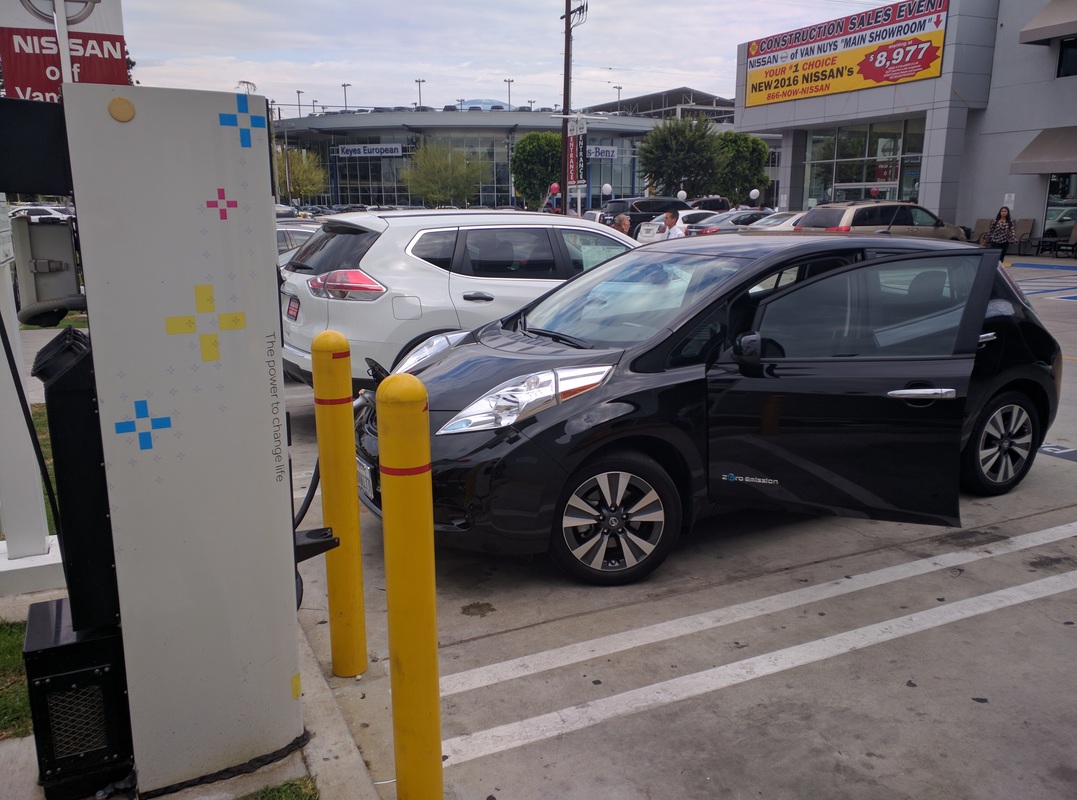|
With so many variables, it’s hard to decide on an EV. Here’s what we grappled with in our decision to (Spoiler Alert) lease a 2016 Nissan Leaf:
1.Range anxiety (at 110 miles per charge, is that enough for our family?) 2.Understanding federal and state incentives 3.Degradation in battery life over time – how real is this? 4.Drive-ability 5.Room for 5 people comfortably? 6.Newer models coming out (Tesla 3 and Chevy Bolt) 7.Cost of operation vs gas vehicle 8.How do you install a charger (EVSE) in the garage? 9.How much could we use our solar panels to charge it versus off-grid power? 10.Are those HOV stickers still available in California? 11.Lease vs buy 12.Hybrid vs Pure EV And here is what we found out and decided: 1.Range anxiety is real but do-able with planning ahead At 110 miles, that’s 50 miles each way with a 10-mile cushion. Luckily stop-and-go traffic seems to help EVs, since they regenerate some energy during braking, the opposite of gas cars. So the 10-mile cushion seems fairly safe. With the ability to trickle charge at your destination, that can add 5-10 miles per hour, and that’s possible with a standard 110V outlet and the free cable that comes with the car. With a 240V Series 2 charger on the other end, you can add 20 miles per hour to your battery and really extend your range. And if you plan around a DC charger, such as most Nissan dealers have, you can go 80+ miles, get an 80% recharge in 30 minutes and head home. So for us, we have a gas car for long trips and we will use the EV for all around town and mid-range trips of 50 miles or less, 80 miles or less with ability to charge on the other end. 2.Federal and state incentives The dealers were offering $7,500 federal rebates, and $2,500 state rebates in California, although the state money was contingent of renewal of the program, so we couldn’t take that for granted. By leasing, the $7,500 was rolled into the deal, along with other dealer incentives that pushed the capital cost reduction well over $10K. We’ll hope to get the state rebate, too. The government continues to do its best to give EVs a start in the market dominated by internal combustion engines. 3.Degradation of battery life over time The research we made showed we could expect 70% battery life after 5 years or so, and that charging behavior is a key determining factor in this. Just like a cellphone battery, if you charge it often, the battery loses its ability to hold a charge faster. So we’ve been trying to run it down under 50% before recharging. But if we have a possible trip the next day, we’ll have to top it off in the garage. With a lease, this is not a large issue. 4.Drive-ability This is answered by test driving, and your local dealer would love you to do so, because they’re so convinced you’ll be hooked that you’ll probably get one. They really are a joy to drive. The big difference I noticed right away was acceleration. There is no delay between putting the pedal down and the engine responding, so it’s peppy. Acceleration on the freeway onramp is scary easy. And the Leaf handles turns and braking nicely as well. I’ve never been so excited about driving a new car as this one, and I’ve probably driven a dozen new cars over the years. 5.Room for 5 people Because they have to count their pounds like the Weight Watchers of car designers, EVs are not as roomy as their gas cousins. But I found the Leaf had plenty of room for 3 in the back seat 6. Wait for new models or pull the trigger now? We had a career change that made this decision for us. And the 3-year lease gives us a timetable to get to where the new Teslas, Chevys, and Nissans have worked out some bugs and extended range on affordable models to 200+ miles. Then our next EV can be all the car we’d ever need to go between LA and San Francisco with one stop or go to the mountains. But if I had a car with 2 years left in it, I would have run it into the ground and waited for the next generation of EVs. 7.Cost of operation This breaks down into gas vs electricity cost and maintenance and insurance cost differences, if any. Let’s assume we’re getting 3.8 miles/kwh on the Leaf (which we are). At $0.20/kwh, that’s about $0.05/mile. A comparable gas car might get 30 miles per gallon on $3/gallon gas. That’s $0.10/mile (double). Plus, maintenance should be much less for an EV, with fewer moving parts under the hood. And insurance on the Leaf was less than our other cars. So we stand to save $750/yr on gas alone at 15,000 miles/yr. 8.Chargers 101 You don’t call it a charger, first of all! The EV community seems pretty stubborn about calling them EVSE’s. So we’ll have to go with that until a TV show character gives one a cooler name. For now, I’ll call it a charger. I found some for $300, but ended up getting a Clipper Creek one for $600 that everyone swore by. I had a 30 amp RV plug at 240V already on the back of the garage, and planned to use that. But that could only handle the 24 amp charger. The 32 amp charger would make a big difference in charging speed, so I had my electrician upgrade the breaker to 40 amps and ran a new line in the garage. It is charging from nothing to full in about 5 hours. The brains of the whole charging thing is in the car. The car knows when to turn off the charger. The car can set a timer to turn on and off at a certain time to take advantage of off-peak electric rates. All you need that EVSE to do then is safely move the current. You might spend your first year’s gas savings on an EVSE and installation. 9.Using solar power to charge the car We have an excess of solar PV capacity on the roof of about 1,000 kwh/year, or 3,800 miles per year worth. The utility pays us $0.04/kwh for that power, as part of our net metering agreement, so that’s a bum deal. We might as well use it for an EV. That means the first 3,800 miles per year are at $0.01/mile. Then we start paying Tier I rates from the utility. But, even in the middle of summer in the middle of the day, when our PV panels are maxed out, they only produce 4 kw, and the charger uses 6.6 kw, so we can’t charge at full blast without help from the grid. All that comes out in the end-of-year wash, when the utility calculates what we took versus what we returned to the grid, regardless of what time of day it was. Net metering is a good deal for the consumer, who gets to use the grid whenever their panels can’t power them as a virtual battery, and just clear up their account at the end of the year, like those general store owners used to do in all the Westerns when the farmers sold their crops for the year and bought their wives and daughters fabric to make dresses. 10.HOV stickers in California We wanted one of those mud flap stickers like on those Priuses when they first started strutting their environmental superiority over our gas cars 15 years ago. But we also heard those stickers aren’t available any more. Well it seems that’s true, for hybrid EVs (check your specific model at the DMV website). But for our ZEV (zero emission vehicle), they have a shiny white HOV lane sticker available by mail for $22, once you get your registration in the mail. And until then, you can drive the carpool lane with impunity since you have no plates; just watch for the highway patrolman. 11.Lease vs buy We bought our solar panels when leasing them would have been easier, so we’re not lease lovers. But with the longer range models coming online in the next year or two, and the dealers’ willingness to take all the uncertainty and paperwork out of the federal rebate process for us, and a sub-$300/month lease on offer with a reasonable downpayment, we decided on the 15,000/mile a year lease. 12.Hybrid vs Pure EV A plug-in hybrid seems like the perfect compromise … the economy of an EV driving around town near home with the range of a regular gas car. But we just wanted to make more of a statement than that … that we can plan around limited range and charging stations to make an electric vehicle with no emissions work. And why spend an extra $2,000 or so to have a redundant engine under the hood – that’s not a no-cost compromise. My wife and I just have come to believe through our research that the natural gas plant down the street can burn gas and make electricity and get it to our house to charge our car more efficiently than the oil companies can get gasoline to the gas station by way of the refinery by way of the ship from the Middle East for my gas engine to burn. And if 30-50% of the power comes from my rooftop solar panels or solar panels in the Mojave Desert or hydropower, then I think that makes a pure EV make good sense now and, even more so, in future.
0 Comments
|
AuthorNick Brown, CEA Archives
August 2022
Categories
All
|
Proudly powered by Weebly


 RSS Feed
RSS Feed